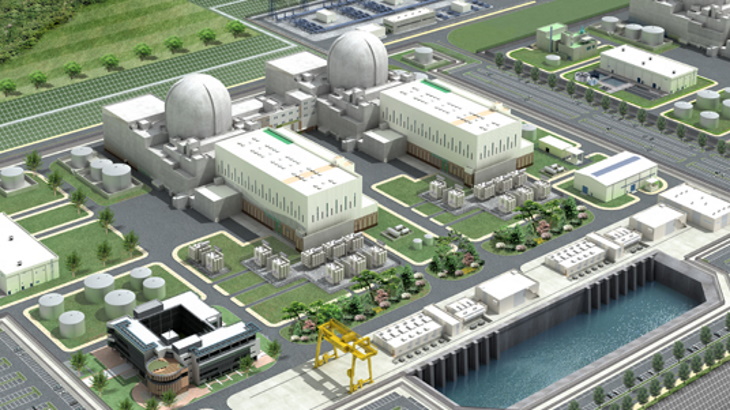Russia's BN-800 unit brought to minimum controlled power
The fourth reactor at Russia's Beloyarsk nuclear power plant has for the second time been brought to the minimum controlled power level, moving it a step closer to starting commercial operation.
The BN-800 reactor was first brought to minimum controlled power on 27 June 2014, with the start of operation planned for the end of that year. But in December, Russian nuclear power plant operator Rosenergoatom announced that nuclear fuel for the unit would first be developed further. The unit is now expected to start operations before the end of this year.
The 789 MWe BN-800 Beloyarsk 4 is fuelled by a mix of uranium and plutonium oxides arranged to produce new fuel material as it burns. Its capacity exceeds that of the world's second most powerful fast reactor - 560 Mwe Beloyarsk 3.
According to an article in the latest edition of the Fast Neutron nuclear industry newspaper, the BN-800 sodium-cooled fast neutron reactor unit completed the last stage of physical start-up on 30 July and reached 0.13% of minimum controlled power the following day.
The procedure was witnessed by Viktor Saruda, general director of Uralenergostroy, which has been the general contractor for all the Beloyarsk units.
Saruda was quoted as saying that construction work at the plant has been a "bridge between the past and the future".
"Design decisions made as far back as Soviet times have had to be corrected because 30 years later more effective solutions have appeared," he said. "This bridge has connected the old and young generations, letting us bring up young builders and operators. Personnel for the construction and operation of future nuclear power plants have been established."
Last November, Uralenergostroy was selected in an open tender as the general contractor for the MBIR construction project at the site of the Research Institute of Atomic Reactors (RIAR), in Dimitrovgrad. MBIR is the Russian acronym for multipurpose sodium-cooled fast neutron research reactor. Regulator Rostechnadzor issued a construction licence for MBIR in May this year.
According to Fast Neutron, once all stages in the first criticality of the BN-800 unit have been completed, Beloyarsk NPP will produce reports for Rosenergoatom and Rostechnadzor to enable changes to be made to the Beloyarsk plant's licence and the transition to the start of operations at the new unit.
Another Fast Neutron article describes Beloyarsk 4 as the future "breadwinner" for the new centralized 'dry' interim storage facility (ISF) at the Mining and Chemical Combine (MCC) in Zheleznogorsk, Siberia. The facility has been built to store used fuel from Russia's RBMK-1000 and VVER-1000 reactors.
Russia's stated policy is to close the nuclear fuel cycle as far as possible and utilize recycled uranium, and eventually also to use plutonium in mixed-oxide (MOX) fuel. In 2011 only about 16% of used fuel was reprocessed, but the target is 100% by 2030.
This strategy has four main elements. The RT-1 used fuel reprocessing facility at Mayak will be updated and then decommissioned in about 2030. At MCC, a MOX fuel fabrication plant for fast reactors will be completed this year; a pilot demonstration centre for used nuclear fuel reprocessing will be completed by 2016; a full-scale RT-2 facility will be completed to reprocess VVER, RBMK and BN used fuel into MOX fuel or into Remix — the regenerated mixture of uranium and plutonium oxides; and used fuel pool storage will be replaced with dry storage.
Fundamental features of the BN-800 reactor include an active reactor protection system with a passive system that works automatically in the event of loss of sodium-cooling liquid pressure, Rosenergoatom has said. During normal operation, the reactor's control rods float in the cooling liquid on top of the reactor core. If the pressure of the cooling liquid dropped, the rods would fall into vertical control rod channels in the reactor core and stop a chain reaction by absorbing neutrons. It also has a passive supplementary air cooling system, used to remove of residual decay heat.
The Beloyarsk plant, which is in the Sverdlovsk region in central Russia, has two shut down reactors and one in commercial operation – Beloyarsk 3. The planned Beloyarsk 5 BN-1200 will use larger fuel elements than the BN-600 and BN-800 and have a simplified refuelling procedure.
Russian nuclear engineering company OKBM Afrikantov is developing a BN-1200 reactor as a next step towards future reactor designs, commonly known as Generation IV.
But in April, Rosenergoatom postponed construction of the BN-1200 unit "indefinitely" on the need to improve fuel for the reactor and amid speculation about the cost-effectiveness of the project. The reactor had been scheduled to start commercial operation in 2025, depending on experience of operating the pilot Beloyarsk 4.
Researched and written
by World Nuclear News

_92619.jpg)











